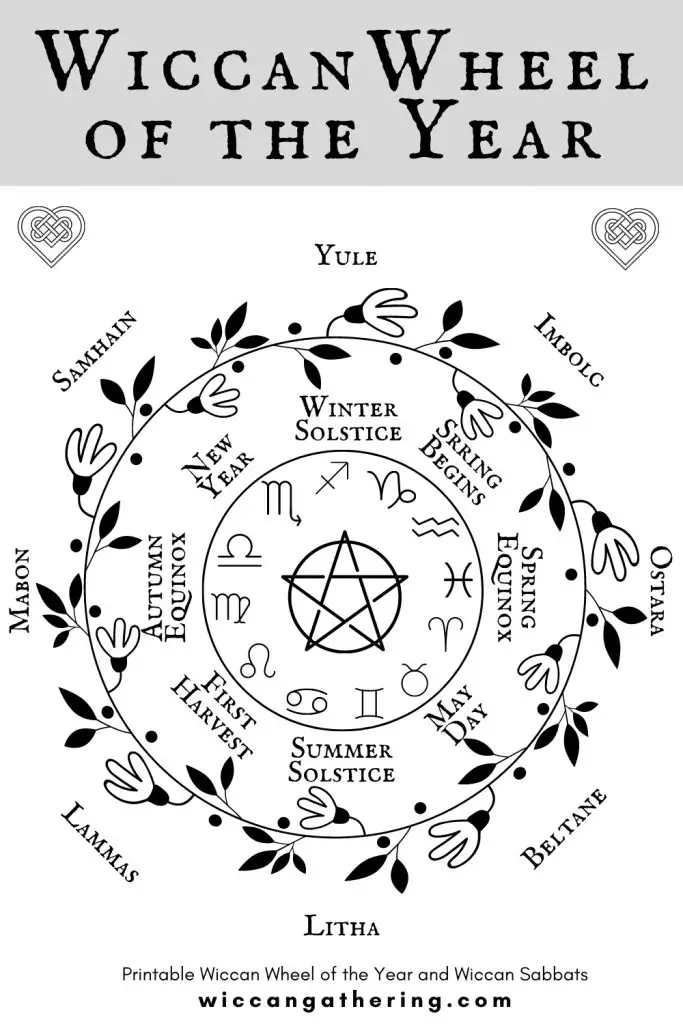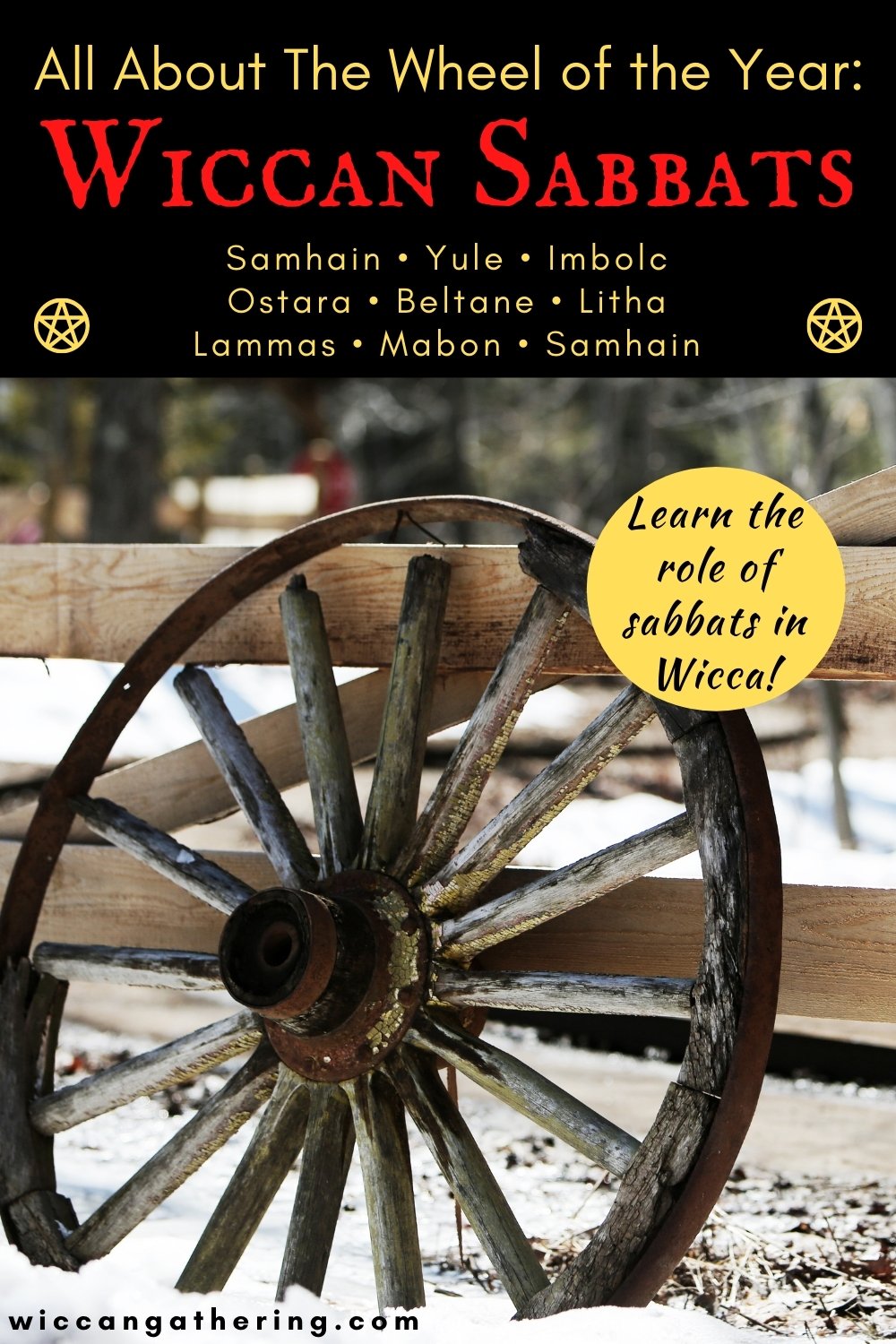Disclosure: Wiccan Gathering is reader-supported, so posts may contain affiliate links. When you click on affiliate links on our site, we may earn a small commission, at zero cost to you. If you enjoyed our content and want to pay it forward (even if you don’t intend to buy anything) please click on any of our product links. Blessed be!
The Wiccan sabbats are a powerful component of Wiccan belief! While beliefs vary from person to person, coven to coven, and tradition to tradition, all Wiccans honour the sacred sabbats and the Wheel of the Year. So, what are they exactly?
The eight Wiccan sabbats, or holidays, form spokes of the Wiccan Wheel of the Year. As time passes, the Wheel turns. The sabbats are marked by natural events like solstices and equinoxes, and indicate the harvest season. Together, the Wheel represents a powerful saga about the two Wiccan deities.
Now that we have a brief overview, let’s dive into some of the specifics about the Wiccan sabbats and the Wheel of the Year.
Psst– Keep reading to find our FREE printable Wheel of the Year to include in your Book of Shadows!
Wiccan Wheel of the Year
The Wheel of the Year is essentially the Wiccan calendar. Practically, it provides a common chronology and serves as a collective ritual structure for amongst all Wiccans.
As time passes, and each successive sabbat celebrated, the Wheel is said to turn.
One full turn of the Wheel represents all eight sabbats. It also represents one Gregorian year. (A Gregorian year is a traditional calendar year.) So a turn of the Wheel is a full journey of the Earth around the Sun.
However aside from this precise astrological meaning of the Wheel, there are many figurative meanings as well.
Cyclical Nature of Time
The Wheel represents the cyclical nature of time in our universe. Not just monthly and seasonal time, but also lifespans. Just as the Wheel has no beginning or no end, neither does the cycle of creation and destruction in our universe.
Existence is constantly created and destroyed, only to be created. This is true whether it be the waxing and waning of the moon, the ebbs and flows of the tides, or the journey from youth to procreation to death.
All of nature is cyclical and this is exactly what the Wheel illustrates.
Tale of The Wiccan Goddess and God
Within Wicca, the Wheel also tells a powerful story about the Goddess and the God. It portrays the two deities in important roles– first as lovers, then as parent and child.
FYI This tale is a characteristic facet of Wicca, so if you are pagan you may not be familiar with it.
In the Wiccan mythology, as Wheel of the Year spins, a timeless saga is played out. In it is the Goddess, who represents the Earth, and the God who represents the Sun.
As Earth and Sun, their relationship drives the cycle of death and rebirth in a delicate balance between male and female energies. Let’s learn more.
The Sun King
As the Sun, the God’s life explains the presence and strength of sunlight throughout the year.
The God is born at Yule, the darkest day of the year and when the sunlight is at its weakest. His birth provides the promise of light to come.
As he grows, the God becomes stronger and more powerful, just as the sunlight strengthens and peaks at the summer solstice. Once he reaches the height of his power, the God starts to age, weaken, and eventually dies at Samhain.
However, we are not to worry because he will be reborn again at Yule, and spread light to the world yet again!
The Earth Mother
As the Earth, the Goddess is steadfast and ever-present. She is a constant, guiding force in the universe.
The Goddess and God are lovers, forming a union and conceiving at Beltane. The Goddess nurtures her pregnancy throughout the warm summer and autumn months.
As Samhain arrives, the God has died. However at the next sabbat of Yule, the Goddess gives birth to the infant God! Exhausted, she falls asleep and rests until Imbolc at the first of spring, where the Goddess and God resume there relationship as lovers and the cycle continues!
Free Printable Wiccan Wheel of the Year
Use this handy grimoire page in your Book of Shadows. It depicts the Wheel of the Year, the eight sabbats, natural events and other holidays, and the zodiac sign as we pass through the Wheel.

Wiccan Sabbats
Now that we know all about the Wheel of the Year and its remarkable tale, let’s look at the individual Wiccan sabbats.
The eight unique sabbats form the spokes of the Wheel of the Year. Each sabbat is a festival spaced roughly six weeks apart.
The sabbats are determined by solstices and equinoxes, which are demarcations of the Earth’s position in relation to the sun.
Solstices are the longest and shortest days of the year, in terms of the amount of sunlight they receive. The summer solstice is the longest day of the year with the most daylight, and the winter solstice is the shortest with the most darkness.
Equinoxes are points in time when daytime and nighttime are equal in length. There is one equinox in the spring, and one in the autumn.
Together, these solar dates comprise four sabbats and fall in December, March, June, and September. They are known as the Lesser Sabbats or Sun Sabbats.
The remaining four sabbats are known as the Greater Sabbats. They are also termed the Earth Sabbats or Cross Quarter Days because they are not tied to the Earth’s position relative to the Sun.
These sabbats fall in February, May, August, and October. They generally fall midway between the four Solar Sabbats, and they often have a historic counterpart, which is an older pagan festival that was celebrated in provincial Europe hundreds of years ago.
You might be confused about the terms Greater Sabbat and Lesser Sabbat. The non-solar sabbats are instead associated with the Earth. Because the steadfast Goddess rules over the Earth, the Earth sabbats are considered to have greater power and energy than the Sun Sabbats. Hence the terms Greater Sabbat and Lesser Sabbat.
Overview of The Eight Wiccan Sabbats
Here is a brief overview of each of the sabbats individually. We have in-depth guides on each sabbat, with a link provided in the descriptions. So please visit those if you’d like detailed information on a particular sabbat!
Also, please note that the dates for each sabbat are not constant. Their precise times depend on natural processes that do not correspond to our Gregorian calendar. Festivals are also sometimes bumped a few days to coincide with the weekend for convenience. So the dates can vary by tradition, coven, or geographic location.
| Sabbat | Natural Event / Tradition | Approximate Date |
| Samhain | New Year | 31 October |
| Yule | Winter Solstice | 21 December |
| Imbolc | Brigid’s Day | 1 February |
| Ostara | Spring Equinox | 21 March |
| Beltane | May Day | 1 May |
| Litha | Summer Solstice | 21 June |
| Lammas | First Harvest | 1 August |
| Mabon | Fall Equinox | 21 September |
1. Samhain
Samhain is the first sabbat as it’s considered the Witches New Year. It’s often the biggest and most grand sabbat celebration for Wiccans. Samhain
is the first sabbat as it’s considered the Witches New Year. It’s often the biggest and most grand sabbat celebration for Wiccans. Samhain

























During this time of the year, the border between us and the spirit world is thin. Since spirits can cross over easily, we typically reach out to them on Samhain.
Full Samhain guide here

























2. Yule
Yule



















































On this shortest and darkest day of the year, we have hope of spring. We light candles and decorate our homes with evergreen foliage to welcome the return of light and life.
Full Yule guide here

























3. Imbolc
Imbolc



















































Imbolc is also called Brigid’s Day, because many Wiccans use Imbolc to worship Brigid, the Celtic Triple Goddess. On Imbolc, we bid farewell to winter, prepare for fresh beginnings, and purify mind, body, and spirit.
Full Imbolc guide here

























4. Ostara
Ostara

























As spring is a fertile time for the Earth, we celebrate all things related to rebirth. Ostara

























Full Ostara guide here

























5. Beltane
Beltane

























On the Beltane

























Full Beltane guide here

























6. Litha
Litha



















































Full Litha guide here

























7. Lammas
Lammas



















































Full Lammas guide here

























8. Mabon
Mabon

























On Mabon

























Full Mabon guide here

























Celebrating Wiccan Sabbats
So, we know all about the Wiccan sabbats and what they mean. How do we celebrate them?
Sabbats are a great time for Wiccans to come together, whether it be physically or spiritually. Even as a solitary practitioner, you can know that on your sabbat rituals, you are joining in with the collective energies of every other Wiccan across the world.
Your sabbat celebrations can encompass many things!
- Altar decorations
- Rituals
- Offerings
- Food and feasting
- Spellwork
- Personal Growth
- Meditations
- Charity
Feasting
Wiccan covens generally hold a grand feasts on sabbats. If you are a solitary, you may be able to find a public sabbat celebrations. Some covens choose to offer public rituals to promote tolerance and understanding of the Wiccan faith.
However if you’re unable to find one, you can always host your own dinner. Eat, drink, and be merry with non-Wiccan friends and family in the spirit of the sabbat.
Seasonal Celebration
As the sabbats are tied to natural cycles like planting, harvesting, animal life, and weather patterns, sabbats are best celebrated when honouring emphasising these seasonalities. Here are a few examples.
In spring and summer, the season is all about growth, rebirth, and fertility. So you could:
- Decorate your altar with fresh flowers
- Give offerings of abundance like honey
- Perform a ritual to plant seeds for future growth
In autumn and winter, the seasons are about completing the harvest, winding down, and slumbering through the winter. You might:
- Decorate your altar with a fall cornucopia
- Give offerings of autumnal harvest like apples
- Perform a ritual of introspection and personal growth
Deepen Connection to Nature
Sabbats offer powerful reminders for us to get in touch with our natural roots. Although Wicca is an Earth-based religion, and we know we should be connecting with nature on daily basis, we often don’t.
Even with well meaning intentions, our modern lives are far removed from the natural world.
We light our homes using electricity, so the solstices and equinoxes don’t have much practical effect on our lives. We buy our produce in the grocery store, which was planted, grown, and harvested by someone else. So we don’t need to know much about the growing cycle.
Although we have opportunities to commune with nature on a daily basis, sabbats are great opportunities to really see the importance of the seasons and the rhythms of nature in our daily lives.


